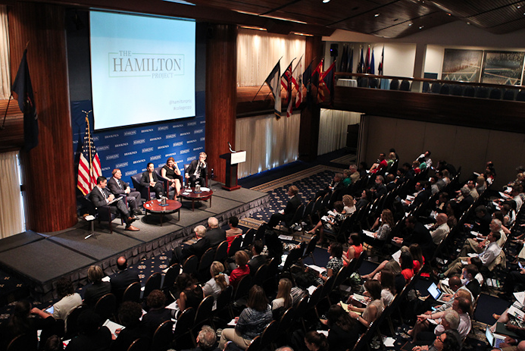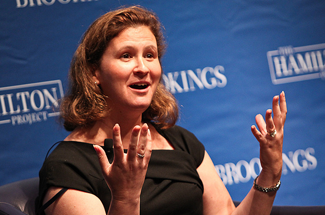
WASHINGTON–Nicole Hurd has met many stellar low-income students who believe college is not an option for them. As director of the National College Advising Corps, she has made it her mission to inspire these students to pursue their dreams despite economic hardship, and she leads a staff of recent college graduates who serve as academic mentors.
On Wednesday, at a Brookings Institution forum about expanding college opportunity, Hurd told the story of a straight-A student in her senior year of high school who had not taken her SATs before walking into Hurd’s office. The student was not sure if she was college material, but her mentor convinced her to register for the SATs and apply to selective colleges. That student was admitted to Yale University.

Unfortunately, stories like these are extremely rare. The vast majority of high-achieving, low-income students in America are not applying to selective colleges. They are eight times less likely to apply to selective colleges than high-income students with the same credentials, and they send the bulk of their college applications to nonselective colleges, according to research which the Brookings Institution released earlier this year.
Changing this behavior was the goal of a recent experiment conducted by economists Caroline Hoxby and Sarah Turner. Hoxby, a Stanford professor, and Turner, a University of Virginia professor, mailed high-achieving, low-income students information about their college options and financial aid estimates and measured how much the information impacted the students’ choices about where to apply to college. Students who received this data made dramatically different decisions about their college applications than their low-income peers who did not receive it. They applied to 19% more colleges and to substantially more selective schools than those in the control group, and they were 78% more likely to be admitted to a top university.
Usually, generating this kind of public policy impact is expensive, but in this case, the intervention was cheap. It cost $6 per student reached. The experiment was sponsored by the Brookings Institution as part of its Hamilton Project, which is aimed at developing policies that increase social mobility, spur economic growth and bring citizens financial security. This research was released online on Wednesday in a paper called “Informing Students About their College Options,” and it was discussed at a forum in the National Press Club.
All of the education experts who spoke at Wednesday’s forum agreed that it was important for high-achieving, low-income students to fulfill their academic potential and apply to colleges with smart students like themselves. Some described college as a path to the American Dream, and William Fizsimmons, Harvard’s director of admissions, said it was imperative that low-income students were not left behind. “I don’t think any country can waste talent, and that’s the thing that is scary,” he said. “This country is leaving a huge amount of talent on the table.”
Hoxby agreed. “As a society, we really do not want to leave talent on the table, because it was hard for students to figure out how to use their talents best,” she said. Hoxby observed that low-income students often lacked basic information about the college application process, since many of those surveyed in her study reported that they did not know the names of competitive colleges that provided financial aid.
Hoxby said she was concerned that this ignorance was preventing low-income students from achieving their potential.
William Kirwin, the chancellor of the University of Maryland, said that this information gap threatened the American Dream. “We can’t be the America we’ve always thought of ourselves as being if we don’t address this issue,” he said.
Hoxby explained that the goal of her mailing experiment was to enable low-income students to make smart academic choices based on reliable information, and she said she hopes to expand the reach of her mailings so students can get academic advice earlier in their high school careers. She is partnering with the College Board, which has promised to distribute her information packets nationwide and to provide her with the data necessary for the Expanding College Opportunities Project, and she hopes that others will provide additional information to low-income high achievers about college.
“We are interested in working with community organizations that could recognize kids that fit the profile,” she said.
Photos courtesy of the Hamilton Project / Flikr. Captions: Top: The Hamilton Project’s Michael Greenstone, Harvard College’s William Fitzsimmons, Stanford University’s Caroline Hoxby, National Advising Corps’ Nicole Farmer Hurd, and the Brookings Institution’s Robert Gordon participated in a roundtable discussion on a new strategy for reaching low-income, high-achieving students. Bottom: National College Advising Corps’ Nicole Farmer Hurd participated in a roundtable discussion on a new strategy for reaching low-income, high-achieving students.
Ilana Kowarski is a former State House correspondent for MarylandReporter.com and a recent graduate from the Columbia Journalism School. She has previously written for The Christian Science Monitor and The Chronicle of Higher Education.






























